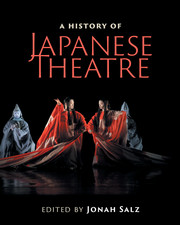Book contents
- Frontmatter
- Contents
- List of figures
- List of tables
- Contributors
- Contributors’ biographies
- Foreword
- Acknowledgments
- Note on Japanese terms
- List of abbreviations
- Timeline
- Editor's introduction
- I Traditional theatres
- Preface to Part I Japanese civilization arises
- 1 Ancient and early medieval performing arts
- Interlude Katari narrative traditions: from storytelling to theatre
- 2 Noh and Muromachi culture
- Interlude Noh and kyogen costumes and masks
- 3 Kyogen: classical comedy
- Interlude Iemoto : the family head system
- 4 Kabuki: superheroes and femmes fatales
- Interlude Nihonbuyo: classical dance
- Interlude Okinawan theatre: boundary of Japanese theatre
- 5 Bunraku: puppet theatre
- Interlude Misemono and rakugo : sideshows and storytelling
- Interlude Kamigata geinō : Kyoto-Osaka style
- Interlude Traditional theatre tomorrow: interview with Takemoto Mikio
- II Modern theatres
- Preface to Part II
- III Arcs and patterns
- IV Theatre architecture
- Preface to Part IV Evolution of Japanese theatre architecture
- V Theatre criticism
- VI Intercultural influences
- Epilogue: Frozen words and mythology
- Further reading
- Index
- References
Interlude Noh and kyogen costumes and masks
from Preface to Part I Japanese civilization arises
Published online by Cambridge University Press: 05 July 2016
- Frontmatter
- Contents
- List of figures
- List of tables
- Contributors
- Contributors’ biographies
- Foreword
- Acknowledgments
- Note on Japanese terms
- List of abbreviations
- Timeline
- Editor's introduction
- I Traditional theatres
- Preface to Part I Japanese civilization arises
- 1 Ancient and early medieval performing arts
- Interlude Katari narrative traditions: from storytelling to theatre
- 2 Noh and Muromachi culture
- Interlude Noh and kyogen costumes and masks
- 3 Kyogen: classical comedy
- Interlude Iemoto : the family head system
- 4 Kabuki: superheroes and femmes fatales
- Interlude Nihonbuyo: classical dance
- Interlude Okinawan theatre: boundary of Japanese theatre
- 5 Bunraku: puppet theatre
- Interlude Misemono and rakugo : sideshows and storytelling
- Interlude Kamigata geinō : Kyoto-Osaka style
- Interlude Traditional theatre tomorrow: interview with Takemoto Mikio
- II Modern theatres
- Preface to Part II
- III Arcs and patterns
- IV Theatre architecture
- Preface to Part IV Evolution of Japanese theatre architecture
- V Theatre criticism
- VI Intercultural influences
- Epilogue: Frozen words and mythology
- Further reading
- Index
- References
Summary
In the rule-laden, formalized performance traditions of noh and kyogen, costuming – including masks and fans – is one vital means for interpretation. Although on stage (as in life) the age, gender, profession, and status of a character determine the outfit to be worn, the color combinations, design patterns, and specific masks within a generic type are fundamentally the actor's choice.
Interpretation
On the bare noh stage, the ability of costume and mask to express season and scene, and to evoke emotional state, stature, and the non-human, was recognized by Zeami (1363?–1443?) already in the fifteenth century. In the Fūshikaden 風姿花伝 (Transmitting the flower through effects and attitudes), he goes so far as to define the portrayal of certain roles by their costume, particularly roles that cannot be played realistically by a male actor, such as women, deities, and Chinese. Zeami also comments on the effectiveness of other actors’ costuming – an expressive element that adds a fresh touch to a well-known piece.
The actor chooses a costume within codified rules. Today noh libretti (utaibon) stipulate mask and costume elements for each character, down to fans, small properties, headgear, and under-robes. The type of mask and style of broad-sleeved outer cloak (ōsode) and box-sleeved kosode robe were determined by the mid-Edo period (1603–1868) according to traditions of each noh or kyogen school.
In preparing for a performance, the shite actor often starts by selecting the specific mask within a name-type; there are over two hundred, about eighty being standard stock for a family-based theatre troupe. The types, such as beshimi (clenched mouth) or ko-omote (small face, see Figure 9), define unique iconographies carved and painted to detailed specifications, such as curvature of silhouette, placement and thickness of eyebrows, and even number of loose strands of hair. Most types, however, are not play-specific, but can be used for any number of roles. Conversely, each mask of a type, however closely it follows an ideal model in measurement, modeling, and painting, contains a unique spirit – this is what the actor assesses in making selections.
When choosing his garments, the actor has the greatest freedom in selection of color and pattern. Outside the use of red (iroari) to indicate youth, color choice is informed by centuries of associations generated by plant dyes used for aristocratic dress.
- Type
- Chapter
- Information
- A History of Japanese Theatre , pp. 62 - 67Publisher: Cambridge University PressPrint publication year: 2016

